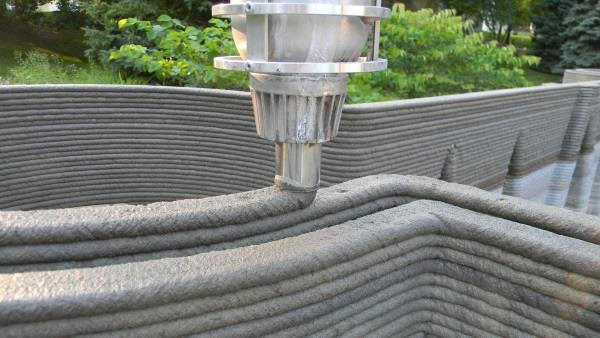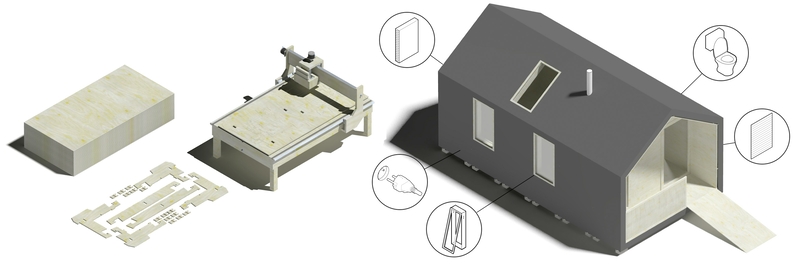3D printing in construction
Contents |
[edit] Introduction
3D printing (sometimes referred to as Additive Manufacturing (AM)) is the computer-controlled sequential layering of materials to create three-dimensional shapes. It is particularly useful for prototyping and for the manufacture of geometrically complex components.
It was first developed in the 1980s, but at that time was a difficult and expensive operation and so had few applications. It is only since 2000 that it has become relatively straightforward and affordable and so has become viable for a wide range of uses including product design, component and tool manufacture, consumer electronics, plastics, metalworking, aerospace engineering, dental and medical applications, and footwear.
The sales of AM machines, or '3D printers' has grown rapidly and since 2005, the home use of 3D printers has become practical.
3D printing systems developed for the construction industry are referred to as 'construction 3D printers'.
A 3D digital model of the item is created, either by computer-aided design (CAD) or using a 3D scanner. The printer then reads the design and lays down successive layers of printing medium (this can be a liquid, powder, or sheet material) which are joined or fused to create the item. The process can be slow, but it enables almost any shape to be created.
Depending on the technique adopted, printing can produce multiple components simultaneously, can use multiple materials and can use multiple colours.
Accuracy can be increased by a high-resolution subtractive process that removes material from an oversized printed item. Some techniques include the use of dissolvable materials that support overhanging features during fabrication.
Materials such as metal can be expensive to print, and in this case it may be more cost-effective to print a mould, and then to use that to create the item.
[edit] Construction industry
In the construction industry, 3D printing can be used to create construction components or to 'print' entire buildings. Construction is well-suited to 3D printing as much of the information necessary to create an item will exist as a result of the design process, and the industry is already experienced in computer aided manufacturing. The recent emergence of building information modelling (BIM) in particular may facilitate greater use of 3D printing.
Construction 3D printing may allow, faster and more accurate construction of complex or bespoke items as well as lowering labour costs and producing less waste. It might also enable construction to be undertaken in harsh or dangerous environments not suitable for a human workforce such as in space.
[edit] Examples of projects
In 2014, engineers at Arup used 3D printing to fabricate a steel node for a lightweight structure. Salomé Galjaard, team leader at Arup said, 'This has tremendous implications for reducing costs, cutting waste and enables a very sophisticated design…'
Professor Behrokh Khoshnevis at the University of California has developed a process of 'contour crafting' using concrete to produce small-scale models of the external and internal walls of houses and is testing a giant transportable 3D printer that could be used to build the walls of a house in 24 hours. The robotic system requires a flat ground slab with underground services in place. Rails are installed either side of the footprint to take a gantry crane that spans the building. A nozzle, driven by a computer-controlled crafter then delivers layers of concrete. The layers build up to form an inner and outer skin for each wall, leaving them to be filled later with insulation or concrete.
Shanghai firm WinSun Decoration Design Engineering has used large 3D printers to spray a mixture of quick drying cement and recycled raw materials (ref. BBC). This has enabled them to construct 10 small demonstration 'houses' in less than 24 hours. They have suggested that each house can be printed for less than $5,000. Their system fabricates blocks off-site by layering the cement mix in a diagonally reinforced pattern. The blocks are then assembled on site. Winsun believes it will be possible to use the technique to build larger houses or even skyscrapers in the future. In 2015, they announced they had printed and entire villa and a five-storey apartment building. (Ref. Global Construction Review 21 January 2015.)
A Dutch project is fabricating a full-sized printed house over a period of years in order to demonstrate the potential of the new technology (Ref. BBC 3 May 2014).
In July 2014, Chinese company, Qingdao Unique Products Develop Co unveiled the World's largest 3D printer at the World 3D Printing Technology Industry Conference and Exhibition in Qingdao. Its first job will be to print a 7 m-high Temple of Heaven. (Ref. Construction Manager 1 July 2014.)
In November 2014, Skanska and Loughborough University signed a deal to develop what they describe as the world's first commercial concrete printing robot. (Ref. Construction Enquirer, Skanska to print 3D concrete products.)
In Spain, the first pedestrian bridge printed in 3D in the world (3DBRIDGE) was inaugurated on 14 December 2016 in the urban park of Castilla-La Mancha in Alcobendas, Madrid. The 3DBUILD technology used was developed by ACCIONA, who was in charge of the structural design, material development and manufacturing of 3D printed elements. The bridge has a total length of 12m and a width of 1.75m and is printed in micro-reinforced concrete. Architectural design was done by the Institute of Advanced Architecture of Catalonia (IAAC).
The 3D printer used to build the footbridge was manufactured by D-Shape. The 3D printed bridge reflects the complexities of nature’s forms and was developed through parametric design and computational design, which allows optimising the distribution of materials and maximising the structural performance, being able to dispose the material only where it is needed, with total freedom of forms. The 3D-printed footbridge of Alcobendas represented a milestone for the construction sector at international level, as large scale 3D printing technology has been applied in this project for the first time in the field of civil engineering in a public space.
See also: 3D printing construction market.
[edit] Criticism
Clearly all of these projects have enormous potential. There are questions about how Construction 3D printing can be integrated with other building components, and how they will incorporate services and reinforcement, but in the long term, they should produce better, faster and perhaps lower-cost buildings.
However, systemised construction is not something we have taken to in the UK. There was a brief boom in panelised systems for high-rise apartment blocks following the Second World War, but many of the resulting buildings were monotonous and ugly, often with condensation problems. There is a resurgence of interest in the UK regarding panelisation and prefabrication, however market share remains low.
All of these innovations require complex equipment, and whilst it is possible to envisage using some simplified version to manufacture specialist components on a more industrial scale, it is questionable whether this will replace bricks and mortar.
[edit] WikiHouse
An alternative approach to digital fabrication of buildings is being developed with the 2D 'WikiHouse' project. WikiHouse, is not an additive process, but an open-source set of construction information for building components which can be downloaded, manufactured and assembled using local, commonly-available materials and equipment. This is low-tech prefabrication which requires little training.
A WikiHouse plugin for Google SketchUp enables users to generate cutting files for components which can be manufactured from standard sheet materials such as plywood using a CNC (computer numerical control) machine. The components are then assembled, with joints formed using pegs and wedges. The resulting frames can be raised and assembled by hand and then cladding panels attached and services and windows installed. It is claimed that the 'chassis' for a single-storey house can be built in a day.
[edit] Related articles on Designing Buildings
- 3D concrete printer.
- 3D-printed house
- 3D concrete printing market.
- 3D printed bridge.
- 3D Printed Office Dubai.
- 3D printing construction market.
- 3D printing Michelangelo's David in concrete.
- Advanced construction technology.
- Advanced manufacturing.
- At a glance - 3D printing.
- BSRIA Briefing 2021.
- Building information modelling.
- Computer aided manufacturing.
- ConTech.
- Digital techniques for heritage restoration.
- Innovation - the key to success.
- Offsite manufacturing.
- Printing 3D models of buildings.
- WikiHouse.
[edit] External references
- EPSRC, Centre for Innovative Manufacturing in Additive Manufacturing.
- BBC, How Dutch team is 3D-printing a full-sized house 3 May 2014
- Contour Crafting.
- MSN, The 3D printer that can build a house in 24 hours, 20 November 2013
- Discover Magazine, The Whole House Machine, 28 April 2005.
- BBC, China: Firm 3D prints 10 full-sized houses in a day. 25 April 2014.
Featured articles and news
Infrastructure that connect the physical and digital domains.
Harnessing robotics and AI in challenging environments
The key to nuclear decommissioning and fusion engineering.
BSRIA announces Lisa Ashworth as new CEO
Tasked with furthering BSRIA’s impressive growth ambitions.
Public buildings get half a million energy efficiency boost
£557 million to switch to cleaner heating and save on energy.
CIOB launches pre-election manifesto
Outlining potential future policies for the next government.
Grenfell Tower Inquiry announcement
Phase 2 hearings come to a close and the final report due in September.
Progress from Parts L, F and O: A whitepaper, one year on.
A replicated study to understand the opinion of practitioners.
ECA announces new president 2024
Electrical engineer and business leader Stuart Smith.
A distinct type of countryside that should be celebrated.
Should Part O be extended to existing buildings?
EAC brands heatwave adaptation a missed opportunity.
Definition of Statutory in workplace and facilities management
Established by IWFM, BESA, CIBSE and BSRIA.
Tackling the transition from traditional heating systems
59% lack the necessary information and confidence to switch.
The general election and the construction industry
As PM, Rishi Sunak announces July 4 date for an election.
Eco apprenticeships continue help grow green workforce
A year after being recognised at the King's coronation.
Permitted development rights for agricultural buildings
The changes coming into effect as of May 21, 2024.

























Comments